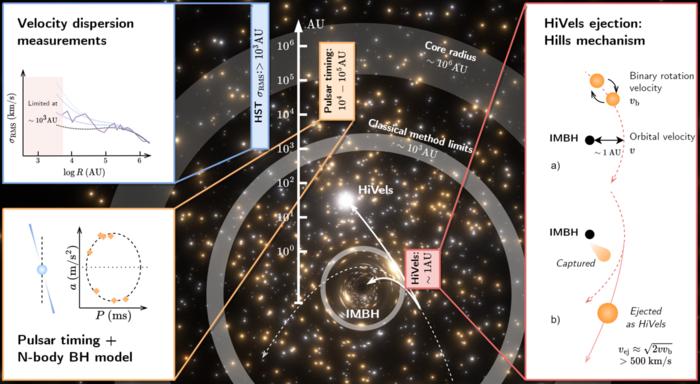Recently, astrophysicists have made groundbreaking advancements in our understanding of intermediate-mass black holes (IMBHs), which serve as a critical link in the evolutionary chain from stellar-mass black holes to supermassive black holes. A team of researchers led by Associate Professor Yang Huang from the University of Chinese Academy of Sciences found compelling evidence for the existence of IMBHs through the study of high-velocity stars ejected from globular clusters. This research is significant, as it combines advanced observational techniques from space-based data, specifically from the Gaia and LAMOST surveys, with theoretical frameworks associated with black hole formation dynamics.
Using an innovative approach, the research team undertook a meticulous examination of nearly a thousand high-velocity stars alongside over a hundred globular clusters located in our Milky Way galaxy. Among their findings, they identified a star named J0731+3717, which was ejected from the globular cluster M15 approximately 20 million years ago. This star attained an astonishing ejection velocity of nearly 550 km/s, revealing a high level of confidence in the reliability of their results, with a significance level of 5.4σ. This extreme velocity not only suggests a dynamic interaction but also points toward the possible presence of an IMBH at the core of the M15 cluster.
The gravitational dynamics involved in the ejection of J0731+3717 provide a compelling case for the Hills mechanism; a theoretical framework that describes how gravitational slingshot interactions can lead stars to be hurled from clusters at high velocities. This research illustrates that an IMBH can significantly alter the trajectories of stars in its vicinity, effectively disrupting binary star systems and allowing researchers to trace the origin of ejected stars back to their dense cluster environments, where evidence of IMBHs is often elusive.
The concept of IMBHs has fascinated astrophysicists for decades, primarily due to the void in observational evidence filling the gap between known stellar-mass black holes and supermassive black holes that anchor galaxies like our own. The formation of these intermediate-mass black holes has been a contentious area of study, characterized by two main theories: rapid formation through the merging of stars within dense stellar environments, and gradual formation through the accumulation of stellar-mass black holes over an extended period.
Historically, the detection of IMBHs has proven challenging. While astronomers have used high-resolution imaging techniques, such as those provided by the Hubble Space Telescope, to infer the presence of these elusive entities in globular clusters like M15, skeptics have questioned their conclusions due to the complex stellar dynamics and the potential presence of numerous compact stars that could confuse observational results. This newer research, however, provides a clearer, more compelling argument by demonstrating a direct link between high-velocity ejected stars and the gravitational influences of IMBHs.
The abundance of stellar data collected from observatories and surveys has allowed for a more nuanced understanding of the relationship between IMBHs and the dense star clusters hosting them. Prior to this research, studies utilizing pulsar timing had hinted at the potential existence of IMBHs, but they struggled to definitively locate the black holes due to the distance of pulsars from the centers of the globular clusters. With the identification of J0731+3717, researchers are now able to position their findings closer to the core of M15, boosting the confidence in their claims regarding the existence of an intermediate-mass black hole lurking within.
Every new detail gathered through this observational study brings scientists one step closer to solving the mystery surrounding IMBHs. Yang Huang and his team have laid the groundwork for future research to focus on additional high-velocity stars, similar to J0731+3717, which could provide further evidence of IMBHs in other globular clusters. The dynamic nature of these clusters, combined with stellar interactions and gravitational slingshot effects, continues to be an area ripe for discovery.
This joint endeavor between multiple research institutions underscores the collaborative spirit prevalent in contemporary astrophysics. It is becoming increasingly apparent that collective knowledge and resources play an essential role in expanding our understanding of the universe, particularly concerning enigmatic entities like black holes. Different facets of astrophysical phenomena must work in unison to fully appreciate the complex interactions governing stellar evolution and black hole formation.
As more data is gathered from ongoing observational efforts such as Gaia and LAMOST, researchers are optimistic about uncovering additional examples of high-velocity stars that can further illuminate our understanding of IMBHs. The recent achievements of Huang’s team not only highlight the need for further explorations into stellar dynamics within globular clusters but also emphasize the importance of advancing observational techniques to unravel cosmic mysteries that have lingered for generations.
Scholars and enthusiasts alike are eagerly awaiting further developments, as the continued discovery of high-velocity stars could revolutionize our comprehension of cosmic evolution and the underlying mechanisms driving the formation of black holes. The implications of this research extend beyond merely understanding black holes; they weave into the fundamental fabric of astrophysics, bridging gaps in our knowledge and challenging existing paradigms.
In conclusion, the significant findings surrounding the high-velocity star J0731+3717 have opened new avenues for exploration in the quest to unravel the mysteries of intermediate-mass black holes. The research conducted by Yang Huang and his collaborators not only reinforces existing theories but also prompts a reevaluation of our approaches to studying the enigmatic phenomena that govern our universe. This discovery ultimately strengthens the narrative connecting stellar evolution to black hole formation and solidifies IMBHs as pivotal players in the vast celestial theater we inhabit.
Subject of Research: Intermediate-Mass Black Holes and High-Velocity Stars
Article Title: Evidence of Intermediate-Mass Black Holes from High-Velocity Star Ejections
News Publication Date: February 2025
Web References: National Science Review
References: National Science Review
Image Credits: ©Science China Press
Keywords
Intermediate-Mass Black Holes, High-Velocity Stars, Gravitational Slingshot, Stellar Dynamics, Globular Clusters




